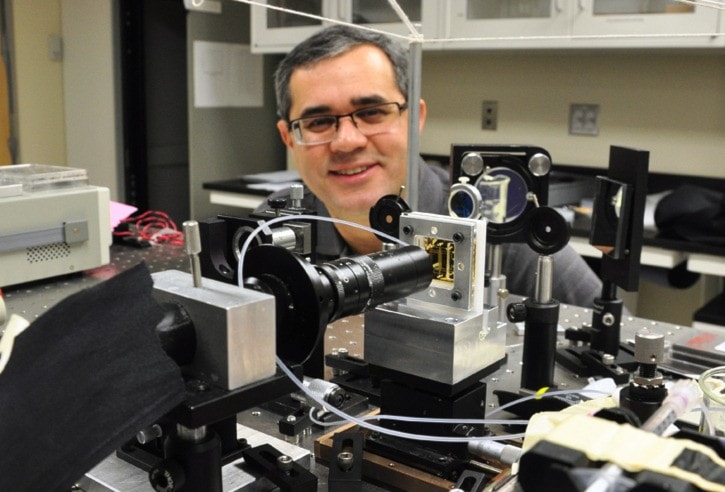In a windowless room of a University of Victoria engineering lab, a biomedical sensor the size of a postage stamp could hold the answer to a fast and inexpensive way to diagnose disease.
Bright gold and transparent, the sensor is peppered with holes on the scale of a few hundred nanometres B��Ԫ������ַ� 600 times thinner than a human hair B��Ԫ������ַ� and infused with micro-drops of blood provided by a hospital in Toronto.
Shine a laser on the sensor and with a properly calibrated imaging camera, researchers will eventually be able to quickly detect telltale signs of leukemia and other cancers, without biopsies or laboratory blood work.
B��Ԫ������ַ�This is a proof-of-concept device. The nano-structure integrated into this biosensor looks for markers used to ID leukemia,B��Ԫ������ַ� says Alex Brolo, a UVic chemistry professor. B��Ԫ������ַ�ItB��Ԫ������ַ�s not done yet, but its getting there.B��Ԫ������ַ�
This biomedical sensor and its underlying microfluid and nanotechnology are still years away from clinical use, but federal funding announced last week is designed to kick it from the basement lab in the Elliott Building to a viable prototype for industry.
The Canadian Foundation for Innovation (CFI) has committed $7.7 million for the Prometheus Project, a collaboration between UVic, Simon Fraser University, the University of British Columbia and the British Columbia Institute of Technology. It is an effort that seeks to do nothing less than make Victoria and Metro Vancouver a world-class materials science hub.
Brolo, the lead scientist for UVicB��Ԫ������ַ�s arm of Prometheus, said the CFI funding will build on decade of fundamental research into nanotechnology and materials science, which has been backed by a $110 million investment.
B��Ԫ������ַ�The previous investments created a lot of proof-of-concepts, a lot of research ideas that are being tested and look promising,B��Ԫ������ַ� Brolo said. B��Ԫ������ַ�This (funding) can take us to the next level. There is a lot of competition, worldwide competition. This is a hot area with a lot of ideas, but sometimes the best idea doesnB��Ԫ������ַ�t win in the end.B��Ԫ������ַ�
UVic expects to receive about $1.8 million from the CFI and $4.5 million in total through matching provincial funds and contributions from private companies. That funding is earmarked for advanced fabricating equipment, lasers and microscopes for about 20 UVic researchers focused on solar cells, biomedical sensors and quantum computing.
For solar technology, researchers are looking to integrate nano-tubes on to a thin film to vastly improve how solar cells capture light, while also making it flexible and lighter. Nano structures integrated into biomedical sensors could not only quickly detect disease, people could use the sensors to establish a personalized baseline of health.
Brolo said engineered nano-particles could provide better medical imaging of tumours for instance, or such particles could deliver targeted medication.
B��Ԫ������ַ�One drop of blood it can monitor several proteins related to disease in the clinical environment,B��Ԫ������ַ� he said. B��Ԫ������ַ�You donB��Ԫ������ַ�t have to send it to a lab, you can do it for $10 in a clinic.B��Ԫ������ַ�
Typically, researchers manipulate metals such as silver and gold to create nano structures, which in turn have unusual properties at the billionth of a meter scale. Brolo canB��Ԫ������ַ�t give timelines when this research might make the leap from the lab to a company, but he said this is a good time for academics and industry to collaborate.
B��Ԫ������ַ�Universities arenB��Ԫ������ַ�t in the business of making products, it is about training students and creating knowledge,B��Ԫ������ַ� Brolo said. B��Ԫ������ַ�But there is an understanding among academics that its not enough to create knowledge, that if you have a good idea, itB��Ԫ������ַ�s important to translate that into industry.B��Ԫ������ַ�
When and if any of these Prometheus projects will emerge in the real world is hard to know, but its likely UVic Industry Partnerships will eventually investigate if the technologies can be patented, and then licenced or spun off into a company.
Over the past five years, UVic scientists have disclosed at least 60 inventions each year. In 2011-12, Industry Partnerships filed for 16 patents, licenced four technologies and had one spin-off company. UVic gets its cut, either 20 per cent of revenues or a negotiated revenue sharing contract with the researcher.
Jerome Etwaroo, an Industry Partnerships liaison officer, said there are no hard and fast rules on if a technology will survive to commercialization, but it needs to be novel and there needs to be a market.
B��Ԫ������ַ�A lot of technology is being developed at UVic,B��Ԫ������ַ� Etwaroo said. B��Ԫ������ַ�UVic is one of the most innovate universities in Canada.B��Ԫ������ַ�
editor@saanichnews.com



